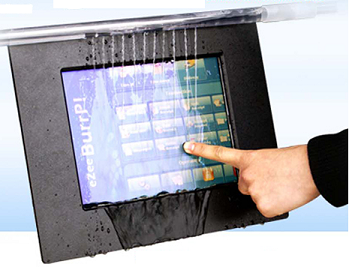When you buy an IP65 monitor, there are a number of pitfalls that you need to be aware of, to make sure you don’t end up buying the wrong model of LCD. The IP rating can be quite confusing, because in addition to the IP rating number itself, there is also the issue of whether the whole monitor carries the IP rating or just the front panel. In addition there are factors other than the IP rating itself that you need to consider, such as temperature range and brightness.
IP Ratings
The IP rating of a monitor is a 2 digit code that specifies how much protection a product has against ingress of solid objects (including dust) and liquids. The first digit refers to the solid or dust protection level, and the second digit is the liquid (water) protection level. The IP rating system is described here in Wikipedia. For example IP65 generally means that the unit is dust tight (no dust ingress), and it can tolerate water jets aimed at it from any direction.Does the IP rating apply to just the front of the monitor, or to the whole monitor?
Several industrial LCD monitors are designed for integration into another panel or cabinet. These are typically the “panel mount” and “open frame” models. These models are often only rated to IP65 from the front, because once they are installed into a panel, it is assumed that the panel (and associated enclosure or wall etc) will prevent water/dust ingress into the back of the monitor. On the other hand there are a smaller number of LCD monitors that are fully IP66 rated, front and back, and hence can be installed as a stand alone monitor in a wet area or outdoors. These typically need to have special waterproof plugs and sockets, as standard electrical connectors are not waterproof.The 5 things to check before buying an IP65 monitor
- Waterproofing: How wet will the monitor actually get – front and back? The second number in the IP rating is the waterproofing level, which may apply just to the front of the monitor, or to the entire monitor. Will the IP65 monitor need to just be protected from occasional drips of water (e.g. inside an equipment room in a ship, or people using it with wet hands), or is it in a wash down area where it could get hosed down with strong water jets every day? Or will it be installed outdoors and have to tolerate heavy storms? It is important to get the waterproofing rating correct, as the monitor can easily be damaged if it gets water inside.
- Dust proofing: How dusty will the monitor actually get – front and back, and will accumulated dust cause a cooling problem? The first number in the IP rating is the dust proofing level. Again this can be only for the front of the monitor or for the entire monitor. Some locations are subject to a lot of dust, for example mine sites, and excessive ingress of dust can prevent the monitor from dissipating heat, with the result that internal parts overheat regularly and shortens the monitor’s lifetime.
- Temperature: How hot or cold will the monitor get, once it is installed in its final location? This can be a critical concern, especially if the unit is in an outdoor location or in an unventilated room or cabinet. Heating from the sun can easily take an outdoor enclosure up to 60 or even 65 degrees C, and there are very few LCD monitors that can withstand 60 degrees under everyday use. If the monitor is outdoors or in an enclosure, It may be necessary to set up a roof to shade it, or install a cooling fan in the enclosure to keep the temperature down.
- Condensation: Will the temperature variations cause water to condense inside the monitor? Condensation will occur when a mass of air is cooled down so far that it can no longer hold its moisture content as water vapor, so the water drops form on any solid object. Hence if the ‘monitor was “sealed up” in a warm, humid environment, then taken to a cold environment, it is very likely that condensation would occur inside the monitor, which could damage it. A similar situation could occur if a monitor is panel mounted in a wall, and the air behind the wall is warm, but the air in front is cold: water could condense inside the monitor. To prevent this, use a fully sealed monitor.
- Brightness: Will the monitor be bright enough and dark enough in the various conditions it will be used in? If the monitor is to be used outdoors then it needs to be rated as “sunlight readable”, which usually means a high brightness backlight. However if it is being used in a control room or marine bridge at night, it would also need to be able to dim down to a very low brightness level. Check that your monitor is specified as “sunlight readable” and/or “wide dimming range” to make sure it is suitable for your application. You might also benefit from a monitor that automatically adjusts its brightness according to the ambient light level – this is available as an option on many CyberVisuell IP65 monitors.
